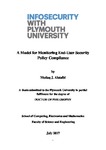A Model for Monitoring End-User Security Policy Compliance
| dc.contributor.supervisor | Furnell, Steven | |
| dc.contributor.author | Alotaibi, Mutlaq | |
| dc.contributor.other | School of Engineering, Computing and Mathematics | en_US |
| dc.date.accessioned | 2017-11-20T15:50:41Z | |
| dc.date.available | 2017-11-20T15:50:41Z | |
| dc.date.issued | 2017 | |
| dc.date.issued | 2017 | |
| dc.identifier | 10365831 | en_US |
| dc.identifier.uri | http://hdl.handle.net/10026.1/10237 | |
| dc.description.abstract |
Organisations increasingly perceive their employees as a great asset that needs to be cared for; however, at the same time, they view employees as one of the biggest potential threats to their cyber security. Organizations repeatedly suffer harm from employees who are not obeying or complying with their information security policies. Non-compliance behaviour of an employee, either unintentionally or intentionally, pose a real threat to an organization’s information security. As such, more thought is needed on how to encourage employees to be security compliant and more in line with a security policy of their organizations. Based on the above, this study has proposed a model that is intended to provide a comprehensive framework for raising the level of compliance amongst end-users, with the aim of monitoring, measuring and responding to users’ behaviour with an information security policy. The proposed approach is based on two main concepts: a taxonomy of the response strategy to non-compliance behaviour, and a compliance points system. The response taxonomy is comprised of two categories: awareness raising and enforcement of the security policy. The compliance points system is used to reward compliant behaviour, and penalise noncompliant behaviour. A prototype system has been developed to simulates the proposed model in order to provide a clear image of its functionalities and how it is meant to work. Therefore, it was developed to work as a system that responds to the behaviour of users (whether violation or compliance behaviour) in relation to the information security policies of their organisations. After designing the proposed model and simulating it using the prototype system, it was significant to evaluate the model by interviewing different experts with different backgrounds from academic and industry sectors. Thus, the interviewed experts agreed that the identified research problem is a real problem that needs to be researched and solutions need to be devised. It also can be stated that the overall feedback of the interviewed experts about the proposed model was very encouraging and positive. The expert participants thought that the proposed model addresses the research gap, and offers a novel approach for managing the information security policies. | en_US |
| dc.language.iso | en | |
| dc.publisher | University of Plymouth | |
| dc.subject | User Behaviour | |
| dc.subject | Information Security Management | |
| dc.subject | Compliance management | |
| dc.subject | Information Security Policy | en_US |
| dc.subject.classification | PhD | en_US |
| dc.title | A Model for Monitoring End-User Security Policy Compliance | en_US |
| dc.type | Thesis | |
| plymouth.version | publishable | en_US |
| dc.identifier.doi | http://dx.doi.org/10.24382/741 | |
| dc.rights.embargoperiod | No embargo | en_US |
| dc.type.qualification | Doctorate | en_US |
| rioxxterms.version | NA |
Files in this item
This item appears in the following Collection(s)
-
01 Research Theses Main Collection
Research Theses Main


